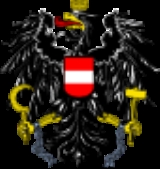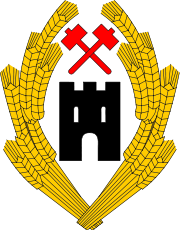
Coat of arms of Austria
Encyclopedia
The current coat of arms of Austria, albeit without the broken chains, has been in use by the Republic of Austria
since 1919. Between 1934 and the German annexation in 1938
Austria used a different coat of arms, which consisted of a double-headed eagle. The establishment of the Second Republic in 1945 saw the return of the original (First Republic) arms, with broken chains added to symbolise Austria's liberation.
of the Federal Arms of the Republic of Austria reads:
There are two different versions of the arms: One version in accordance with the Federal Constitution, in which the eagle is represented plain black, and another more artistic version in which the eagle's feathers are detailed. Both versions are used in parallel.
Discussions about the arms have been triggered in the past by differing political interpretations, especially by the use of the hammer and the sickle and the broken chains, since the crossed hammer and sickle
are a widespread symbol of communism
, as is the breaking of chains. Surveys have however confirmed, that understanding of the actual symbolism of the arms is widespread.
On the one hand the arms serve as a new republican symbol, on the other as a modified version of the historical Habsburg arms. The current version of the arms is often regarded as being reminiscent of the double-headed eagle of the Habsburg monarchy. According to this interpretation, the single headed eagle alludes, in the sense of the removal of the left hand
, "Hungarian" head, to the removal of the eastern part of the Habsburg Empire. However, Addendum 202 to the 1919 Law on the State Arms and the State Seal of the Republic of German Austria states expressly that the "new" single headed Austrian eagle is based not on the double headed eagle (symbol of the Habsburgs since 1804, and previously of the Holy Roman Empire), but rather on the "symbol of the legions of the Roman Republic", the Aquila
. The Austrian federal states have however retained pre-republican heraldic traditions (mostly heraldic images from the Middle Ages, but also diverse accoutrements such as archducal and ducal hats, and knights' helmets).
 On 31 October 1918, the council of state agreed upon the colours of the republic (red-white-red) as well as the new coat of arms composed personally by chancellor Karl Renner
On 31 October 1918, the council of state agreed upon the colours of the republic (red-white-red) as well as the new coat of arms composed personally by chancellor Karl Renner
. The coat of arms was composed quickly due to the need for having a seal at the peace talks after World War I
. The coat of arms consisted of black tower representing the bourgeoisie, two crossed red hammers representing workers and a golden wreath of ears of corn representing farmers. The colours black, red and gold was deliberately chosen because they were the German national colours.
The new coat of arms was however withdrawn as it was met with heavy criticism from, for example, Adolf Loos
and heraldists; the proposal was seen as too similar to commercial advertising. A decision by the council of ministers on 8 May 1919 replaced the tower arms with the eagle.
Austria
Austria , officially the Republic of Austria , is a landlocked country of roughly 8.4 million people in Central Europe. It is bordered by the Czech Republic and Germany to the north, Slovakia and Hungary to the east, Slovenia and Italy to the south, and Switzerland and Liechtenstein to the...
since 1919. Between 1934 and the German annexation in 1938
Anschluss
The Anschluss , also known as the ', was the occupation and annexation of Austria into Nazi Germany in 1938....
Austria used a different coat of arms, which consisted of a double-headed eagle. The establishment of the Second Republic in 1945 saw the return of the original (First Republic) arms, with broken chains added to symbolise Austria's liberation.
Appearance
In translation, the blazonBlazon
In heraldry and heraldic vexillology, a blazon is a formal description of a coat of arms, flag or similar emblem, from which the reader can reconstruct the appropriate image...
of the Federal Arms of the Republic of Austria reads:
Gules a fess Argent, escutcheon on the breast of an eagle displayed Sable, langued Gules, beaked Or, crowned with a mural crown of three visible merlons Or, armed Or, dexter talon holding sickle, sinister talon holding hammer, both talons shackled with chain broken Argent.
There are two different versions of the arms: One version in accordance with the Federal Constitution, in which the eagle is represented plain black, and another more artistic version in which the eagle's feathers are detailed. Both versions are used in parallel.
Symbolism
The symbols and emblems used in the Austrian arms are as follows:- The Eagle: Austria's sovereignty (introduced 1919)
- The escutcheon Emblem of Austria (late Middle Ages, reintroduced 1915)
- The mural crown: The middle class (introduced 1919)
- The sickle: Agriculture (introduced 1919)
- The Hammer: Industry (introduced 1919)
- The broken chains: Liberation from National SocialistNazismNazism, the common short form name of National Socialism was the ideology and practice of the Nazi Party and of Nazi Germany...
dictatorship (added 1945)
Discussions about the arms have been triggered in the past by differing political interpretations, especially by the use of the hammer and the sickle and the broken chains, since the crossed hammer and sickle
Hammer and sickle
The hammer and sickle is a part of communist symbolism and its usage indicates an association with Communism, a Communist party, or a Communist state. It features a hammer and a sickle overlapping each other. The two tools are symbols of the industrial proletariat and the peasantry; placing them...
are a widespread symbol of communism
Communism
Communism is a social, political and economic ideology that aims at the establishment of a classless, moneyless, revolutionary and stateless socialist society structured upon common ownership of the means of production...
, as is the breaking of chains. Surveys have however confirmed, that understanding of the actual symbolism of the arms is widespread.
On the one hand the arms serve as a new republican symbol, on the other as a modified version of the historical Habsburg arms. The current version of the arms is often regarded as being reminiscent of the double-headed eagle of the Habsburg monarchy. According to this interpretation, the single headed eagle alludes, in the sense of the removal of the left hand
Dexter and sinister
Dexter and sinister are terms used in heraldry to refer to specific locations in an escutcheon bearing a coat of arms and by extension also to a crest. "Dexter" means to the right from the viewpoint of the bearer of the arms, to the left of that of the viewer...
, "Hungarian" head, to the removal of the eastern part of the Habsburg Empire. However, Addendum 202 to the 1919 Law on the State Arms and the State Seal of the Republic of German Austria states expressly that the "new" single headed Austrian eagle is based not on the double headed eagle (symbol of the Habsburgs since 1804, and previously of the Holy Roman Empire), but rather on the "symbol of the legions of the Roman Republic", the Aquila
Aquila (Roman)
The Aquila was the eagle standard of a Roman legion, carried by a special grade legionary known as an Aquilifer. One eagle standard was carried by each legion.-History:...
. The Austrian federal states have however retained pre-republican heraldic traditions (mostly heraldic images from the Middle Ages, but also diverse accoutrements such as archducal and ducal hats, and knights' helmets).
The tower arms

Karl Renner
Karl Renner was an Austrian politician. He was born in Untertannowitz in the Austro-Hungarian Empire and died in Vienna...
. The coat of arms was composed quickly due to the need for having a seal at the peace talks after World War I
World War I
World War I , which was predominantly called the World War or the Great War from its occurrence until 1939, and the First World War or World War I thereafter, was a major war centred in Europe that began on 28 July 1914 and lasted until 11 November 1918...
. The coat of arms consisted of black tower representing the bourgeoisie, two crossed red hammers representing workers and a golden wreath of ears of corn representing farmers. The colours black, red and gold was deliberately chosen because they were the German national colours.
The new coat of arms was however withdrawn as it was met with heavy criticism from, for example, Adolf Loos
Adolf Loos
Adolf Franz Karl Viktor Maria Loos was a Moravian-born Austro-Hungarian architect. He was influential in European Modern architecture, and in his essay Ornament and Crime he repudiated the florid style of the Vienna Secession, the Austrian version of Art Nouveau...
and heraldists; the proposal was seen as too similar to commercial advertising. A decision by the council of ministers on 8 May 1919 replaced the tower arms with the eagle.
See also
- Flag of AustriaFlag of AustriaThe flag of Austria has three equal horizontal bands of red , white, and red.The Austrian triband is the second-oldest flag in use at least since 1230, after the Danish flag .- Origins :...
- Flags of Austrian statesFlags of Austrian statesThe flags of the Austrian states show two stripes in the main colours of the respective arms. These flags are the state flags and are shown with the coats of arms, although it is common for them to be shown without it. Without the coats of arms, some flags are very similar, such as those of Tyrol...
- Coats of arms of the Austrian statesCoats of arms of the Austrian statesThe coats of arms of the states of Austria are presented below...

